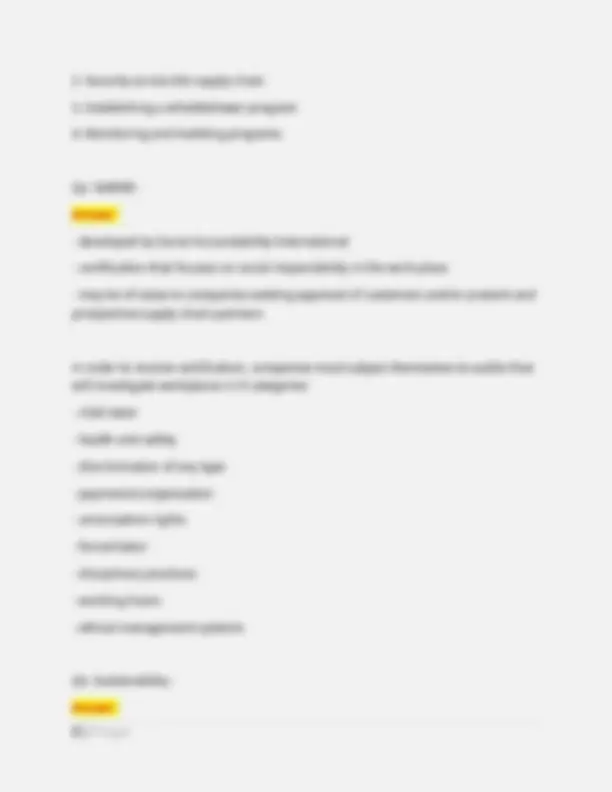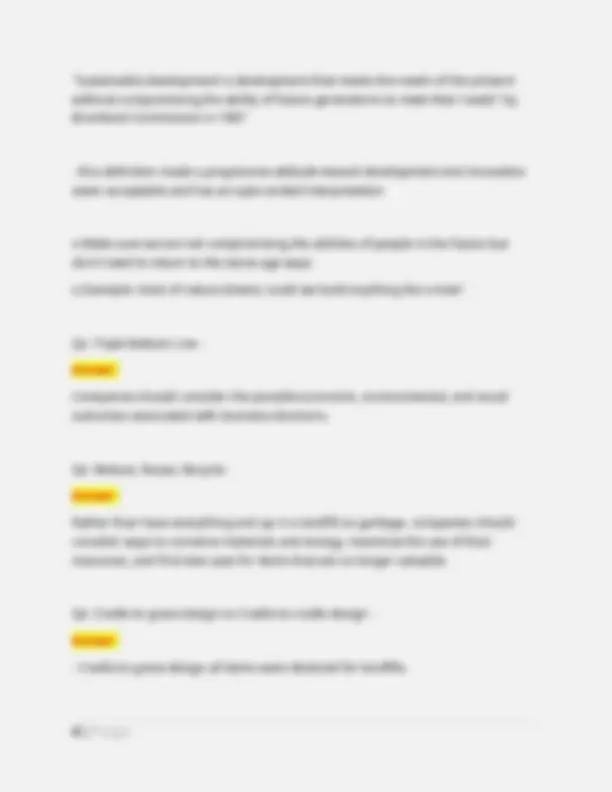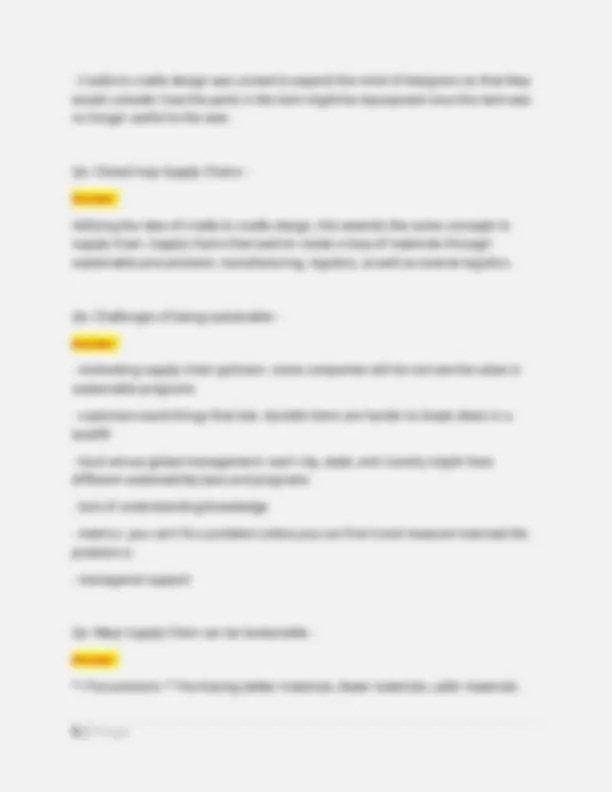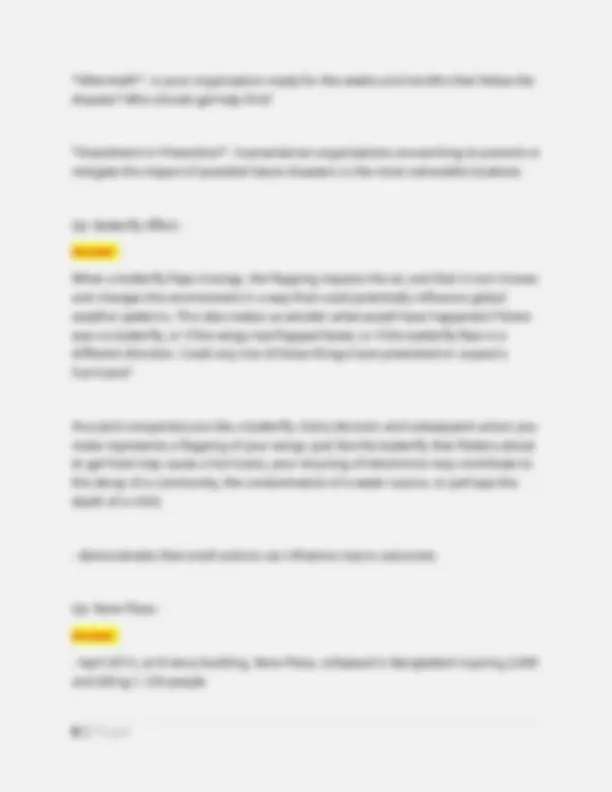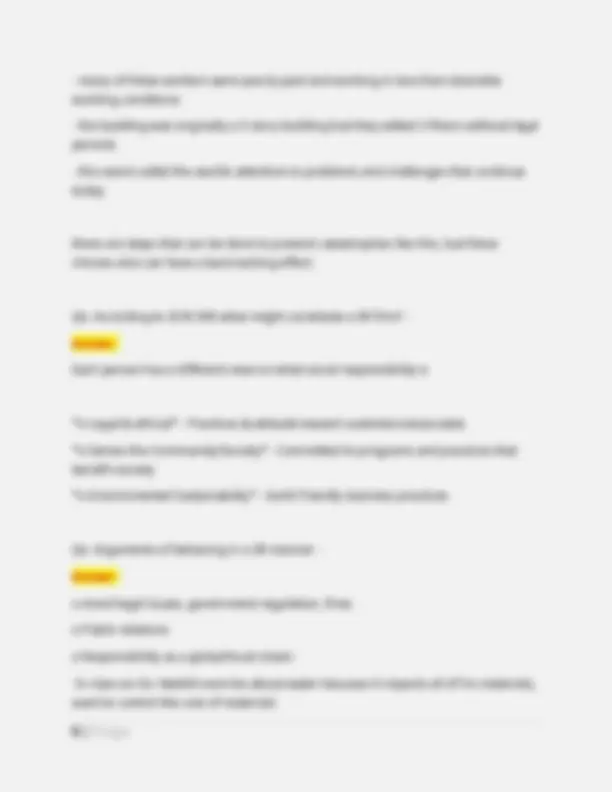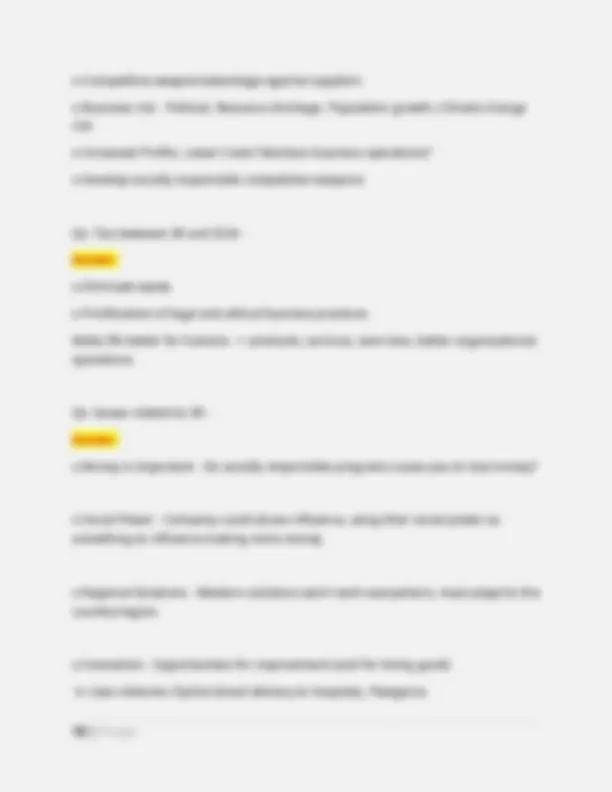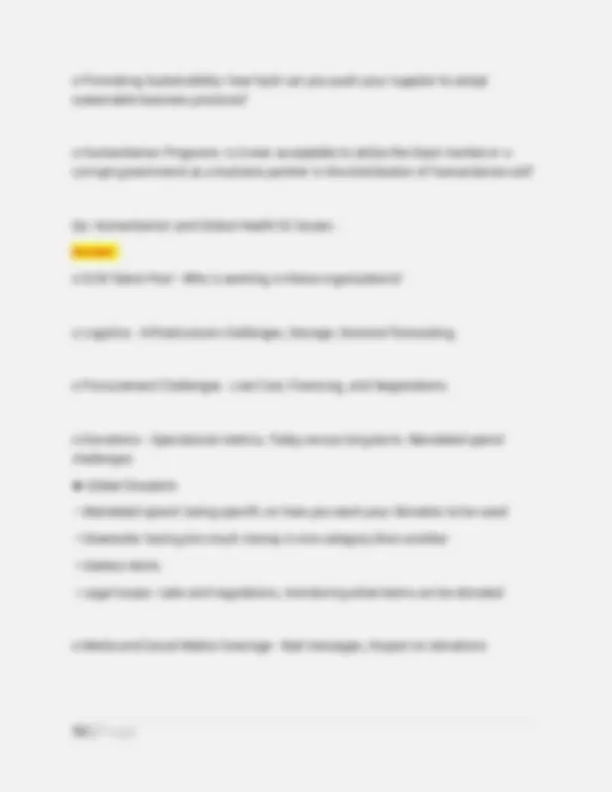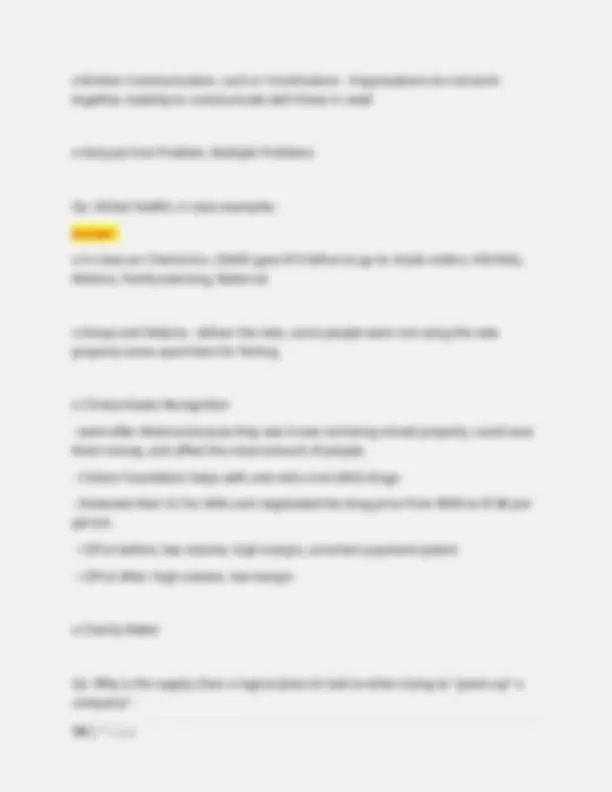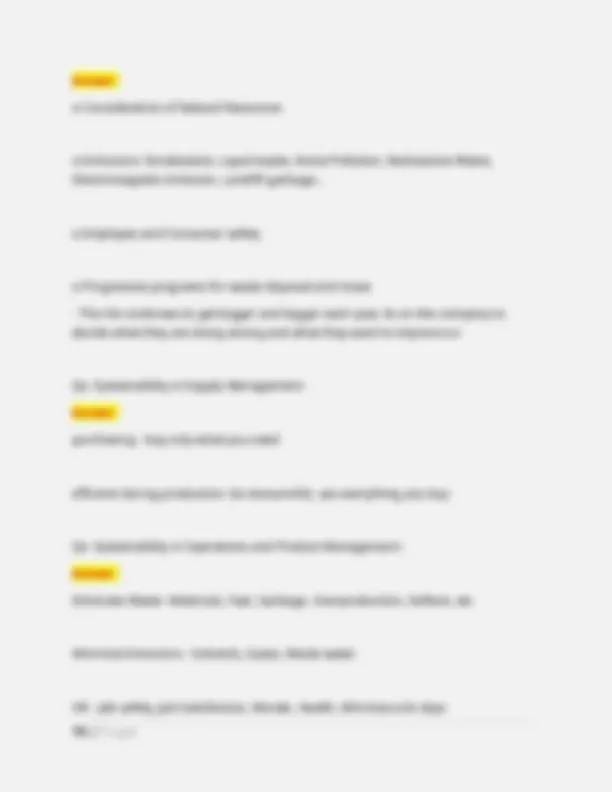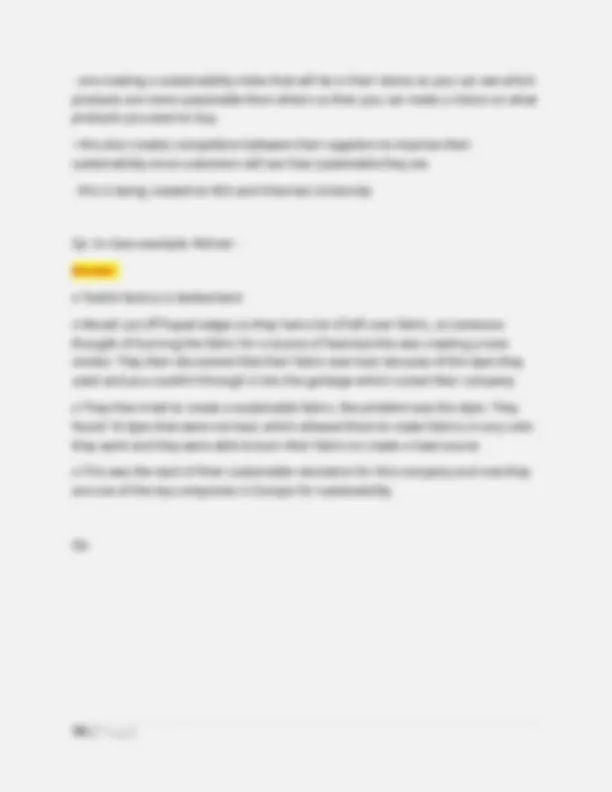Download Social Responsibility in Supply Chain Management: A Study Guide and more Exams Nursing in PDF only on Docsity!
SCM 300- Module 8 / Study Guide
Questions with Definitive Solutions.
3 Parts of Social Responsibility (SR) - Answer:
- legal and ethical behavior - acting within the law in all of the nations in which they conduct business. it might also include treating stakeholders, employees, business partners, and customers well
- Sustainability- earth-friendly business practices. having business practices, products, and services that do not harm the environment in the present nor in the future
- Commitment to the Community- investing in the well-being of the communities in which the business operates as well as the greater world Qs: 4 Reasons to be Socially Responsible - Answer:
- Avoid government fines and regulations
- Seek positive public image
- Demonstrate to customers and employees the company's goals and values
- Protect the company's interests Qs: 3 Links between SCM and SR -
Answer:
- eliminate waste
- Legal and ethical business practices
- Improve quality of life Qs: Challenges of being SR - Answer:
- Whats the right thing to do?
- Monitoring supply chain partners and yourself
- Tracking outcomes across the supply chain Qs: Examples of Ethical Issues in SCM - Answer:
- obey laws
- choosing ethical business partners
- do not bully supply chain partners and/or employees
- conflicts of interest
- protect the environment, workers, and consumers
- breaches in intellectual property, consumer and employee personal data, and confidential business information Qs: 4 Tools of Managing Ethical SC - Answer:
- Continuous Education and Awareness Programs
"Sustainable development is development that meets the needs of the present without compromising the ability of future generations to meet their needs" by Bruntland Commission in 1987
- this definition made a progressive attitude toward development and innovation seem acceptable and has an open ended interpretation o Make sure we are not compromising the abilities of people in the future but don't need to return to the stone age ways o Example: most of nature (trees): could we build anything like a tree? Qs: Triple Bottom Line - Answer: Companies should consider the possible economic, environmental, and social outcomes associated with business decisions. Qs: Reduce, Reuse, Recycle - Answer: Rather than have everything end up in a landfill as garbage, companies should consider ways to conserve materials and energy, maximize the use of their resources, and find new uses for items that are no longer valuable. Qs: Cradle to grave design vs Cradle to cradle design - Answer:
- Cradle to grave design all items were destined for landfills.
- Cradle to cradle design was coined to expand the mind of designers so that they would consider how the parts in the item might be repurposed once the item was no longer useful to the user. Qs: Closed loop Supply Chains - Answer: Utilizing the idea of cradle to cradle design, this extends the same concepts to supply chain. Supply chains that seek to create a loop of materials through sustainable procurement, manufacturing, logistics, as well as reverse logistics. Qs: Challenges of being sustainable - Answer:
- motivating supply chain partners- some companies still do not see the value in sustainable programs
- customers want things that last- durable items are harder to break down in a landfill
- local versus global management- each city, state, and country might have different sustainability laws and programs
- lack of understanding/knowledge
- metrics- you can't fix a problem unless you can find it and measure how bad the problem is
- managerial support Qs: Ways Supply Chain can be Sustainable - Answer: • Procurement - Purchasing better materials, fewer materials, safer materials
identify different types of problems in different parts of the supply chain. The hope is that this will guide managers to create individualized sustainability goals for different departments or functions Qs: ISO 14000 - Answer:
- series of certifications is offered by the International Organization of Standardization in the area of sustainable business practices and management
- this can prove to other companies/potential supply chain partners/customers that your company is committed to sustainability at an organizational level Qs: Different Phases in Humanitarian SCM - Answer: Before the Disaster : how do you prepare for the disaster Securing Supply chain partners the Disaster : being able to respond to any/multiple of these disasters
- quick striking natural disasters= earthquakes, hurricanes, tsunamis
- slow occurring and drawn out natural disasters= drought, famine, disease
- slow occurring and drawn out man made disasters= political unrest that results in emigration to refugee camps, contamination of water sources The Arena of Despair : disaster strikes, its time to act. communication is key
Aftermath : is your organization ready for the weeks and months that follow the disaster? Who should get help first? Investment in Prevention : humanitarian organizations are working to prevent or mitigate the impact of possible future disasters in the most vulnerable locations Qs: Butterfly Effect - Answer: When a butterfly flaps it wings, the flapping impacts the air, and that in turn moves and changes the environment in a way that could potentially influence global weather patterns. This idea makes us wonder what would have happened if there was no butterfly, or if the wings had flapped faster, or if the butterfly flew in a different direction. Could any one of those things have prevented or caused a hurricane? You (and companies) are like a butterfly. Every decision and subsequent action you make represents a flapping of your wings. Just like the butterfly that flutters about to get food may cause a hurricane, your recycling of electronics may contribute to the decay of a community, the contamination of a water source, or perhaps the death of a child.
- demonstrates that small actions can influence macro outcomes Qs: Rana Plaza - Answer:
- April 2013, an 8 story building, Rana Plaza, collapsed in Bangladesh injuring 2, and killing 1,129 people
o Competitive weapon/advantage against suppliers o Business risk - Political, Resource shortage, Population growth, Climate change risk o Increased Profits, Lower Costs? Maintain business operations? o Develop socially responsible competitive weapons Qs: Ties between SR and SCM - Answer: o Eliminate waste o Proliferation of legal and ethical business practices Make life better for humans --> products, services, save lives, better organizational operations Qs: Issues related to SR - Answer: o Money is Important - Do socially responsible programs cause you to lose money? o Social Power - Company could abuse influence, using their social power as something to influence making more money o Regional Solutions - Western solutions won't work everywhere, must adapt to the country/region. o Innovation - Opportunities for improvement (and for doing good) in class video/ex: Zipline blood delivery to hospitals, Patagonia
o Media and Special Interests - The price you pay for saying you are SR not everyone will agree Ex: Walmart o Impact on stakeholders - Customers, employees, supply chain partners, etc. Qs: Ethical issues that global supply chains confront - Answer: o Product and Customer related
- Quality, Safety, Environmental Impact
- ex: Mattel, Firestone, Dog food, Baby formula, Batteries, Toyota... o Supplier
- Relationship - Treatment of partners/suppliers
- Partners' labor and other business practices; Corruption, Bribery, Collusion
- Prices paid and Processes used to develop, acquire, extract...materials o Logistics
- Environmental issues - pollution, landscape o Manufacturing and Labor Related Issues
- Hiring practices - Hiring illegal workers, Children, Wages, Race, Sex, Religion...
- Work conditions - Safety, Health, Hours, Labor unions
o Promoting Sustainability- how hard can you push your supplier to adopt sustainable business practices? o Humanitarian Programs- is it ever acceptable to utilize the black market or a corrupt government as a business partner in the distribution of humanitarian aid? Qs: Humanitarian and Global Health SC Issues - Answer: o SCM Talent Pool - Who is working in these organizations? o Logistics - Infrastructure challenges, Storage, Demand forecasting o Procurement Challenges - Low Cost, Financing, and Negotiations o Donations - Operational metrics, Today versus long-term, Mandated spend challenges ♣ Global Disasters
- Mandated spend- being specific on how you want your donation to be used
- Downside: having too much money in one category then another
- Useless items
- Legal issues- rules and regulations, monitoring what items can be donated o Media and Social Media Coverage - Bad messages, Impact on donations
o Broken Communication, Lack or Coordination - Organizations do not work together, Inability to communicate with those in need o Not Just One Problem, Multiple Problems Qs: Global Health; in class examples - Answer: o In class ex: Chemonics. USAID gave $10 billion to go to 4 task orders; HIV/Aids, Malaria, Family planning, Maternal o Kenya and Malaria - deliver the nets, some people were not using the nets properly some used them for fishing o Clinton/Gates Recognition
- went after Malaria because they saw it was not being solved properly, could save them money, and affect the most amount of people.
- Clinton Foundation helps with anti-retro viral (ARV) drugs
- Dissected their SC for ARVs and negotiated the drug price from $500 to $140 per person
- CIPLA before: low volume, high margin, uncertain payment system
- CIPLA After: high volume, low margin o Charity Water Qs: Why is the supply chain a logical place to look to when trying to "green up" a company? -
Qs: Sustainability in Logistics, Shipping, and distribution - Answer: Fuel consumption, Avoid traffic congestion, Minimize emissions Storage Requirements - Real Estate, Energy to maintain building, etc. Reverse Logistics: Packaging disposal, Pick-up, Repair, Recovery, Salvage Qs: Sustainability in Packaging, Design and Planning - Answer: Materials used, Design, Minimizing storage/transport space Size, Shape and Weight - Fuel and Storage Requirements Qs: Sustainability Challenges and solutions discussed in lecture - Answer: o Do consumers really want sustainable products? o The Expense of Being Sustainable o Regional Legislation o Building Sustainable Supply Chains takes time and collaboration
- Change takes time. How fast can suppliers change?
- Industries must develop and then achieve economies of scale o Are sustainable solutions actually sustainable - Recycling
- Outcomes are sometimes very, sometimes not very good
- Consider entire life cycle trucks to transport the items, the machines to break down the items all release fossil fuels
- The item you get using recycled materials is lower quality water bottles or paper, but items such as metals recycle a lot better o Lack of Reliable Sustainability Metrics
- What actually is the best solution?
- Metrics - comprehensive BUT easy to use, understand, interpret o Similar Products have very different Supply Chains - Life Cycle Analysis o Redesigning products can be difficult and expensive (and risky) o Developing standards and goals
- Different groups require different goals - Where is the waste?
- Important to "know where the garbage is" what departments/areas they need to become more sustainable Qs: In class example: Walmart - Answer:
- are creating a sustainability index that will be in their stores so you can see which products are more sustainable then others so then you can make a choice on what products you want to buy
- this also creates competition between their suppliers to improve their sustainability since customers will see how sustainable they are
- this is being created at ASU and Arkansas University Qs: In class example: Rohner - Answer: o Textile factory is Switzerland o Would cut off frayed edges so they had a lot of left over fabric, so someone thought of burning the fabric for a source of heat but this was creating a toxic smoke. They then discovered that their fabric was toxic because of the dyes they used and you couldn't through it into the garbage which ruined their company o They then tried to create a sustainable fabric, the problem was the dyes. They found 16 dyes that were not toxic which allowed them to make fabrics in any color they want and they were able to burn their fabric to create a heat source o This was the start of their sustainable revolution for this company and now they are one of the top companies in Europe for sustainability Qs:

